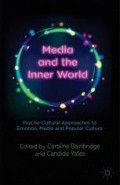Abstract
We live in a culture highly sensitised to its own perceived vulnerability which is socially constructed through dominant, mainstream representations, in particular, broadcast television and national presses. Across all genres, television communicates a host of perceived dangers or risks to human survival as entertainment, responding and reproducing the victim or risk consciousness (Furedi, 2005 [1997]) of the late twentieth and early twenty-first centuries. Terrorism has captured the imaginations of not only politicians but also producer/writers, and, as a consequence of this and the visual spectacle that war and terrorism provide, it has featured regularly and consistently in British and American television programming since the late 1990s.
This chapter was first published as an original article in Free Associations: Psychoanalysis and Culture, Media, Groups, Politics, 62, 85–110. We are grateful for permission to reprint it in full here.
Access this chapter
Tax calculation will be finalised at checkout
Purchases are for personal use only
Preview
Unable to display preview. Download preview PDF.
References
Altheide, D. L. (2002) Creating Fear: News and the Construction of Crisis (New York: Aldine de Gruyter).
Altheide, D. L. (2006) ‘Terrorism and the Politics of Fear’, Cultural Studies-Critical Methodologies, 6(4), 415–39.
Bainbridge, C. and Yates, C. (2012) ‘New Perspectives on Psychoanalysis and Popular Culture’, Psychoanalysis, Culture & Society, 17(2), 113–19.
Bersani, L. (1989) ‘Pynchon, Paranoia and Literature’, Representations, 25(Winter), 99–118.
Bignell, J. (2009) ‘The Police Series’ in Gibbs, J. and Pye, D. (eds) Close-Up 03 (London: Wallflower Press), pp. 1–66.
Biressi, A. (2001) Crime, Fear and the Law in True Crime Storytelling (London: Palgrave/St Martin’s Press).
Blumenthal, S. (2003) The Clinton Wars (New York: Fanar, Strauss and Giroux).
Fairbaim, W. R. D. (1952) Psychoanalytic Studies of Personality (London: Tavistock).
Fairbaim, W. R. D. (1954) ‘Observations on the Nature of Hysterical States’, British Journal of Medical Psychology, 27, 105–25.
Fairbaim, W. R. D. (1958) ‘On the Nature and Aims of Psychoanalytic Treatment’, International Journal of Psychoanalysis, 39, 374–85.
Farrell, K. (1998). Post-Traumatic Culture: Injury and Interpretation in the Nineties (Baltimore: Johns Hopkins University Press).
Figlio, K. and Richards, B. (2003) ‘The Containing Matrix of the Social’, American Imago, 60(4), 407–28.
Freud, S. (1924) ‘Neurosis and Psychosis’ in SE vol. 22 (London: Hogarth Press), pp. 149–53.
Furedi, F. (2005) Culture of Fear: Risk Taking and the Morality of Low Expectation (London: Continuum). Revised edition published 2002. First published 1997 (London: Cassell).
Geraghty, C. (2006) ‘Discussing Quality: Critical Vocabularies and Popular Television Drama’ in Curran, J. and Morley, D. (eds) Media and Cultural Theory (Oxford: Routledge), pp. 221–32.
Grotstein, J. S. (1994) ‘Projective Identification and Counter-Transference: A Brief Commentary on Their Relationship’, Contemporary Psychoanalysis, 30, 578–92.
Gledhill, C. (1987) Home Is Where the Heart Is: Studies in Melodrama and the Woman’s Film (London: British Film Institute).
Hofstadter, R. (2008) The Paranoid Style in American Politics and Other Essays (New York: Random House). Originally published 1964.
Jermyn, D. (2007) Crime Watching: Investigating Real Crime TV (London and New York:I.B.Tauris).
Joyrich, L. (1992) ‘All That Television Allows: TV Melodrama, Postmodernism and Consumer Culture’ in Spigel, L. (ed.) Private Screenings: Television and the Female Consumer (Minneapolis: University of Minnesota Press), pp. 227–52.
Kellner, D. (1995) Media Culture: Cultural Studies, Identity and Politics Between the Modern and the Postmodern (London: Routledge).
Klein, M. (1975) Envy and Gratitude and Other Works 1946–1963 (London: The Hogarth Press). First published 1946.
Knight, P. (2008) ‘Outrageous Conspiracy Theories: Popular and Official Responses to 9/11 in Germany and the United States’, New German Critique, 35(1103), 165–93.
Kracauer, S. (1993 [1927]) ‘Photography’, Critical Inquiry, 19(3), 421–36.
Laïdi, Z. (1998) A World Without Meaning: The Crisis of Meaning in International Politics (London: Routledge).
Lianos, M. and Douglas, M. (2000) ‘Dangerisation and the End of Deviance: The Institutional Environment’ in Garland, D. and Sparks, R. (eds) Criminology and Social Theory (Oxford: Oxford University Press), pp. 103–26.
Luckhurst, R. (2003) ‘Trauma Culture’, New Formations, 50, 28–47.
McNair, B. (2006) Cultural Chaos: Journalism, News and Power in a Globalised World (London: Taylor & Francis).
Meltzer, D. (1968) ‘Tenor, Persecution, Dread: A Dissection of Paranoid Anxieties’, International Journal of Psychoanalysis, 49, 396–401.
Ogden, T. H. (1991) ‘Analyzing the Matrix of Transference’, International Journal of Psychoanalysis, 72, 593–605.
Ortega Breton, H. (2010) ‘Feeling Persecuted? The Definitive Role of Paranoid Anxiety in the Constitution of “War on Terror” Television’ in Brecher, B., Devenney M. and Winter, A. (eds) Discourses and Practices of Terrorism: Interrogating Terror (London: Routledge), pp. 78–96.
Ortega Breton, H. (2013) ‘The Paranoid Style in Spooks/MI-S: Re-Fashioning the Subject’ in de Gregorio-Godeo, E. and Mateos-Aparicio, A. (eds) Culture and Power: Identity and Identification (Cambridge: Cambridge Scholars Publishing), pp. 189–202.
Peni S, Radstone, S., Squire, C. and Treacher, A. (eds) (2007) Public Emotions (London: Pal grave Macmillan).
Radstone, S. (2008) ‘Memory Studies: For and Against’, Memory Studies, 1(1), 31–39.
Richards, B. (1986) ‘Military Mobilisations of the Unconscious’, Free Associations, 7, 11–26.
Robins, K. (1996) Into the Image: Culture and Politics in the Field of Vision (London and New York: Routledge).
Rustin, M. and Rustin, M. (2002) Mirror to Nature: Drama, Psychoanalysis and Society (London and New York: Karnac Books).
Waever, O. (1995) ‘Securitization and Desecuritization’ in Lipschutz, R. D. (ed.) On Security (New York: Columbia), pp. 46–86.
Winnicott, D. W. (1967) ‘The Location of Cultural Experience’, International Journal of Psychoanalysis, 48, 368–72.
Yates, C. (2013) ‘Media and the Inner World: Mapping the Psycho-cultural’ in de Gregorio-Godeo, E. and Mateos-Aparicio, A. (eds) Mapping Identities and Identification Processes: Approaches from Cultural Studies (Bern: Peter Lang), pp. 115–32.
Author information
Authors and Affiliations
Editor information
Editors and Affiliations
Copyright information
© 2014 Hugh Ortega Breton
About this chapter
Cite this chapter
Breton, H.O. (2014). Coping with a Crisis of Meaning: Televised Paranoia. In: Bainbridge, C., Yates, C. (eds) Media and the Inner World: Psycho-cultural Approaches to Emotion, Media and Popular Culture. Palgrave Macmillan, London. https://doi.org/10.1057/9781137345547_8
Download citation
DOI: https://doi.org/10.1057/9781137345547_8
Publisher Name: Palgrave Macmillan, London
Print ISBN: 978-1-349-46655-9
Online ISBN: 978-1-137-34554-7
eBook Packages: Palgrave Social Sciences CollectionSocial Sciences (R0)

